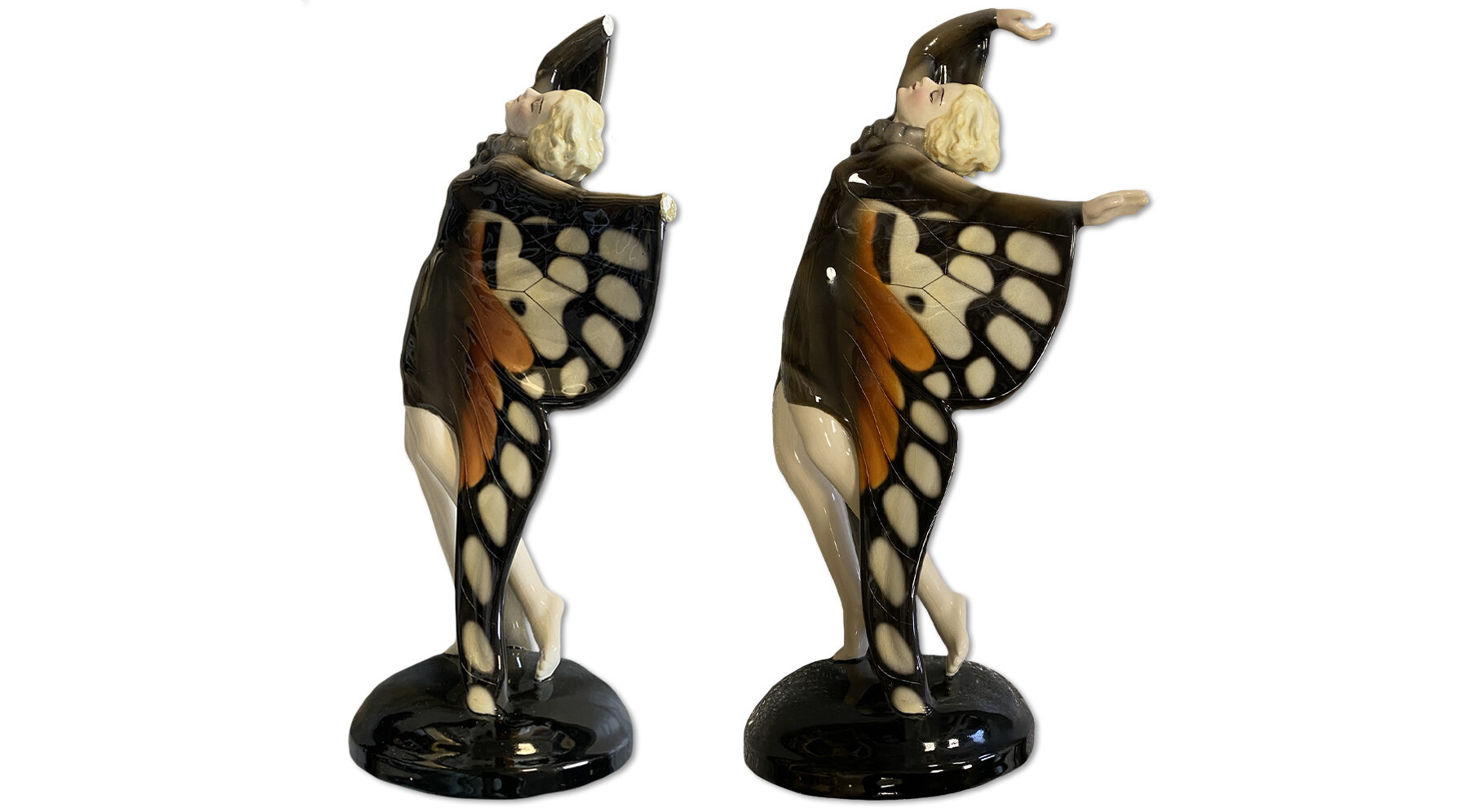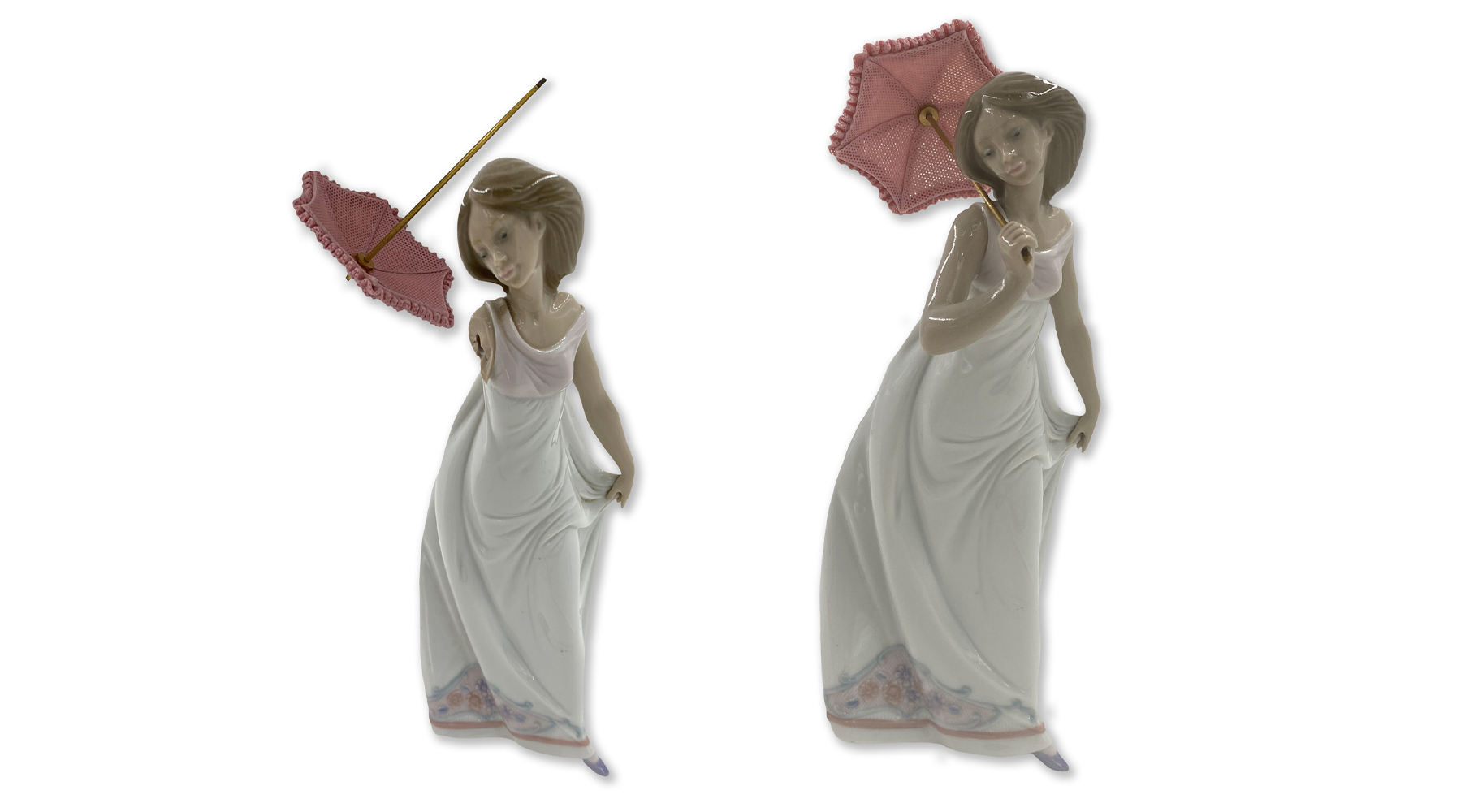Sculpting the human form in a diminutive size is one of the earliest themes in art history, dating as far back as the neolithic period and the famous Venus of Willendorf. Since then, the style has evolved along with the materials made available to artists – from the terracotta grave companions in Tang dynasty China, to the royal porcelain of 18th century Europe.
 Above: a selection of figurines from different eras
Above: a selection of figurines from different eras
Today, ceramic figurines are still a popular choice for collectors around the world. Unfortunately, their fragile appendages are often lost and broken over time. This article will explore the restoration of antique and modern pieces, including their history, materials and how to best care for them at home.
 Above: from left to right – Bow Porcelain musician (1765), Dehua goddess (Ming dynasty), Meissen lady (1736), George Washington (1800-30), and Worcester factory Geisha (1879)
Above: from left to right – Bow Porcelain musician (1765), Dehua goddess (Ming dynasty), Meissen lady (1736), George Washington (1800-30), and Worcester factory Geisha (1879)
Ancient figurines
Throughout ancient history there are various figurative forms, from the Ushabti of Egyptian tombs to the Tanagra sculptures of Hellenistic Greece. The ancient Greeks saw the first mass production of figurines, with small terracotta statues being crafted for decorative and divine purposes. Later, the Roman Empire preferred the use of bronze in their statuary.
 Above: a selection of ancient figurines from Greece and Rome
Above: a selection of ancient figurines from Greece and Rome
Chinese figurines
The Terracotta Army of Qin Shi Huang is a famous example of early figurine craftsmanship. The Terracotta Army is funerary artwork, the collection of over 8000 sculptures was designed to be buried with the emperor, protecting him in the afterlife. Similarly, collectible terracotta figurines from the Tang dynasty were created to be grave companions, aiding deceased as servants, courtesans and entertainers.
 Above: two Tang dynasty figurines, before and after restoration by our conservator
Above: two Tang dynasty figurines, before and after restoration by our conservator
Meissen figurines
The earliest form of porcelain figurines are Ming dynasty Dehua from China, these entirely white pieces were known as Blanc de Chine in Europe. The beginnings of porcelain manufactory in the west started with Meissen, who held the original arcanum for the European process.
 Above: a selection of Meissen figurines from the mid 18th century
Above: a selection of Meissen figurines from the mid 18th century
This saw a boom in the popularity of decorative porcelain, as endless amounts of items could now be produced without the need for expensive and lengthy shipping from Asia. Meissen figurines, like many others from this period, have a range of subject matters. Some of the most popular include costumed performers, mythological gods or goddesses, and pastoral characters.
 Above: a group of Meissen card players, before and after restoration by our conservator
Above: a group of Meissen card players, before and after restoration by our conservator
British figurines
Soon after the success of Meissen, British porcelain began to be produced. Many of the brands we know today started in the 18th century, including Worcester, Derby, Bow, Chelsea and Coalport. You can usually find a maker’s mark on the base on these figurines to indicate their origin.
 Above: three figurine examples from the Chelsea porcelain factory, all 18th century
Above: three figurine examples from the Chelsea porcelain factory, all 18th century
In the mid 19th century, commercial production of figurines began to open up what was once an exclusive decorative art to those outside of the aristocracy. Figurines flourished in Victorian homes as a symbol of good taste and sufficient wealth. By the end of the era, figurines could be found in the homes of all social classes.
 Above: a selection of 19th century figurines
Above: a selection of 19th century figurines
Art deco figurines
In the 20th century, a collectors market began to grow as enthusiasts began to seek out antiques and determine the high values we see in auction rooms today. Modern figurines were also popular, especially in the art deco movement that had a focus on the female form combined with ivory and brushed metal.
 Above: an art deco figurine, before and after restoration by our conservator
Above: an art deco figurine, before and after restoration by our conservator
Film figurines
Due to the success of the film industry in the 1930s, figurines of actors, actresses and characters began to be produced. Early examples include statuettes of Shirley Temple, Mickey Mouse and Snow White. By the 1980s, figurine sales were a staple of movie memorabilia thanks to the Star Wars franchise. Today, movie figurines are not limited to plastic toys but a whole range of materials, from traditional porcelain to contemporary resins.
 Above: a selection of Snow White figurines produced in 1930 by Wade, following restoration by our team
Above: a selection of Snow White figurines produced in 1930 by Wade, following restoration by our team
Lladró figurines
Juán, José and Vicente Lladró founded their porcelain company in 1953. Following on from a tradition of Spanish ceramics, the brand is famous for its high gloss figurines, often finished in a signature pastel palette. Lladró became so popular that it saw the launch of a collectors’ society in 1985. Some of the highest value pieces are intricate and consist of several figures in a group scene. A complex train diorama entitled ‘A Grand Adventure’ can sell from anywhere between £50,000 to £100,000.
 Above: a Lladro figurine, before and after restoration by our conservator
Above: a Lladro figurine, before and after restoration by our conservator
Caring for figurines
Porcelain figurines should be kept behind glass if they have great monetary or sentimental value. This precaution will avoid any disturbances from dust or atmospheric particles and help to prevent accidental knocks and falls. Whether or not an item is in a protective casing, it should always have a felt, leather or soft fabric mat placed beneath it to absorb any shaking from footsteps or vibrations.
If you require display fittings for items such as plates or tableware, always opt for a non-metallic material such as plastic, as this will avoid any scratches or transference of tarnish.
 Above: a conservator assessing a figurine in our studio
Above: a conservator assessing a figurine in our studio
Avoid direct sunlight or humid conditions, we recommend an atmosphere with a steady temperature of around 20 degrees and a relative humidity of around 50%. UV rays from sunlight will cause temperature fluctuations and in some cases, especially when the painted details are over-glaze, chemical reactions or fading may occur.
If you have very sensitive pieces, consider placing UV protective filters on windows or glass casings. If you would like to use an antique vase for display with fresh flowers, consider using a separate container for water within the body of the object, to ensure nothing touches the delicate surface.
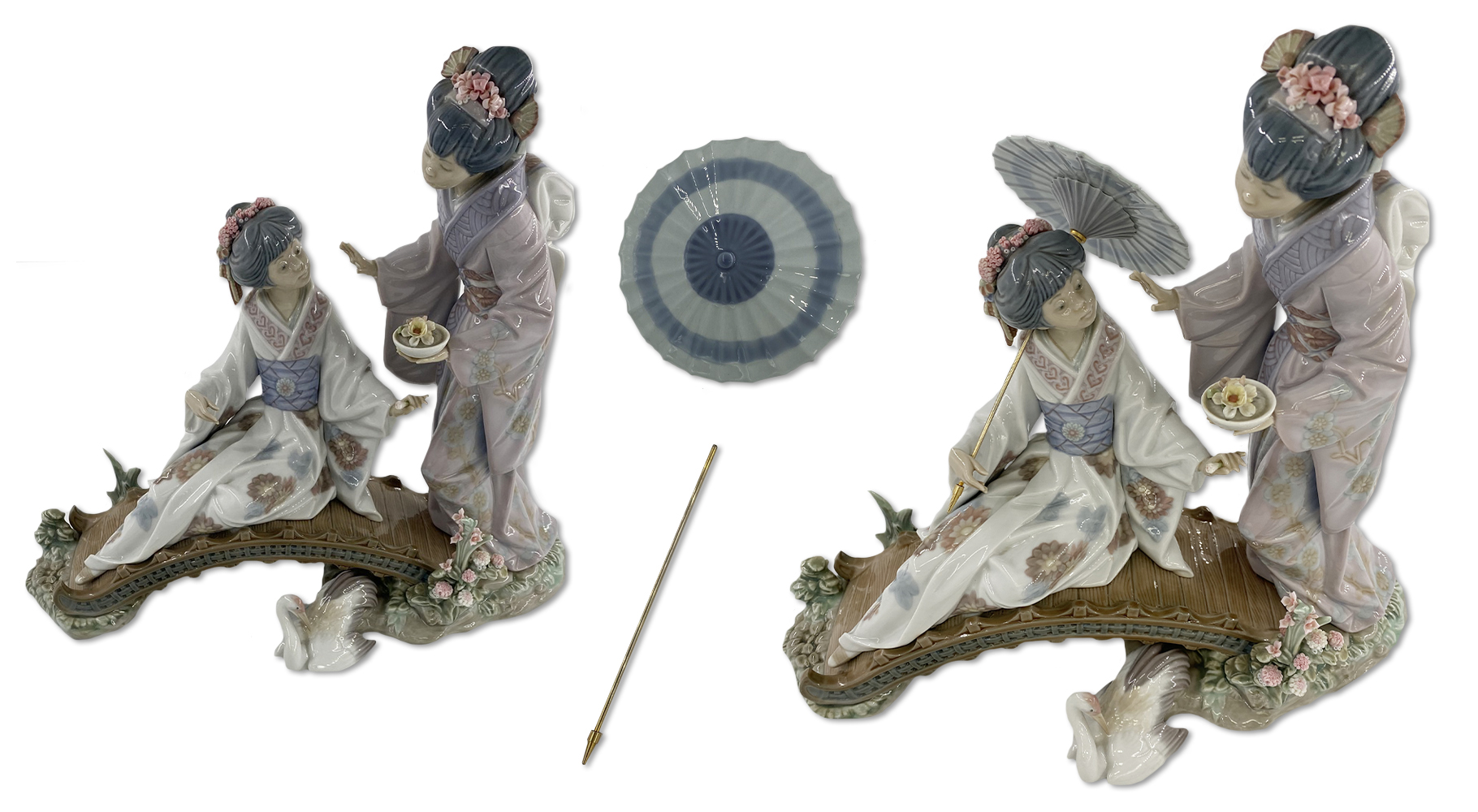
Figurines should be handled as little as possible, but when required this should be performed with clean hands and by carefully holding the item by a strong part of the body – not by the weak extremities such as legs and arms. Do not use anything to stick extra pieces together, instead ensure everything is wrapped separately for storage or transport.
 Above: a figurine undergoing the sensitive removal of old glue
Above: a figurine undergoing the sensitive removal of old glue
Cleaning should only be undertaken when entirely necessary, if an item is stained or heavily soiled by dirt or debris, it may be a task for a conservator to prevent any damage from occurring. Light dusting can be performed with a lint-free cloth, but any abrasive sponges or harsh chemicals should be avoided. If a porcelain piece has over-glaze painting or gilding, take care not to rub these areas, as they have no protective layer.
Porcelain figurine restoration
Our professional ceramics conservator is able to restore porcelain with near-invisible results. This includes the reconstruction of broken pieces with seamless joins and even the recreation of missing parts where required.
If the item has a breakage or missing area, ceramic restoration has several stages. Firstly the item is gently surface-cleaned and weak points are assessed. Any broken edges are prepared for the re-adhesion of original parts or replica pieces. These are applied using conservation-approved solutions that will not yellow or damage the item over time, as a traditional glue would.
 Above: ballet dancers by Lladro, before and after restoration by our conservator
Above: ballet dancers by Lladro, before and after restoration by our conservator
If there are any areas of lost glazing or pigment, our conservator can carefully colour-match and recreate the original appearance. All of these aspects take place over many days as the areas are professionally prepped and allowed to dry. The result is often amazing to our clients, as the original breakage is hard to find due to the perfect finish.
If a porcelain piece is stained or embedded with dust and grime, our conservator can use a customised solution that is the correct strength for the surface of the piece (as not to disturb any original paintwork or gilding). Using small swabs, all areas can be cleaned and the result will be a bright, original surface. This type of work is often conducted following a household disaster, such as a fire, leak or flood, where harmful contaminants may be clinging to the surface.
Whilst a breakage of any kind may affect the value of figurines, restoration conducted to a professional standard will allow the piece to gain a higher value at auction when compared to results for a figurine or tableware item that has missing parts or severe visual disturbances.
How can we help?
If you have any questions about restoration, our team is always happy to help. Email us via [email protected] or call 0207 112 7576

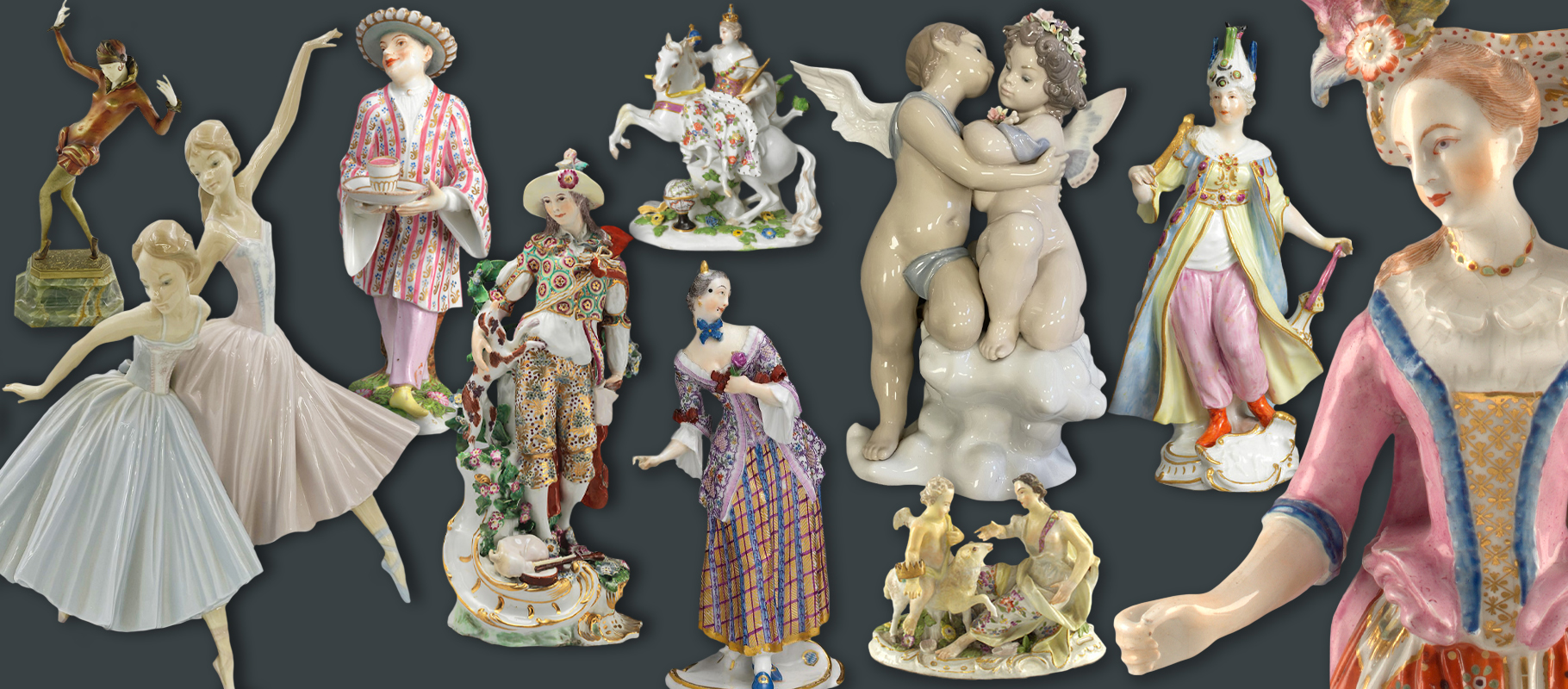 Above: a selection of figurines from different eras
Above: a selection of figurines from different eras Above: from left to right – Bow Porcelain musician (1765), Dehua goddess (Ming dynasty), Meissen lady (1736), George Washington (1800-30), and Worcester factory Geisha (1879)
Above: from left to right – Bow Porcelain musician (1765), Dehua goddess (Ming dynasty), Meissen lady (1736), George Washington (1800-30), and Worcester factory Geisha (1879)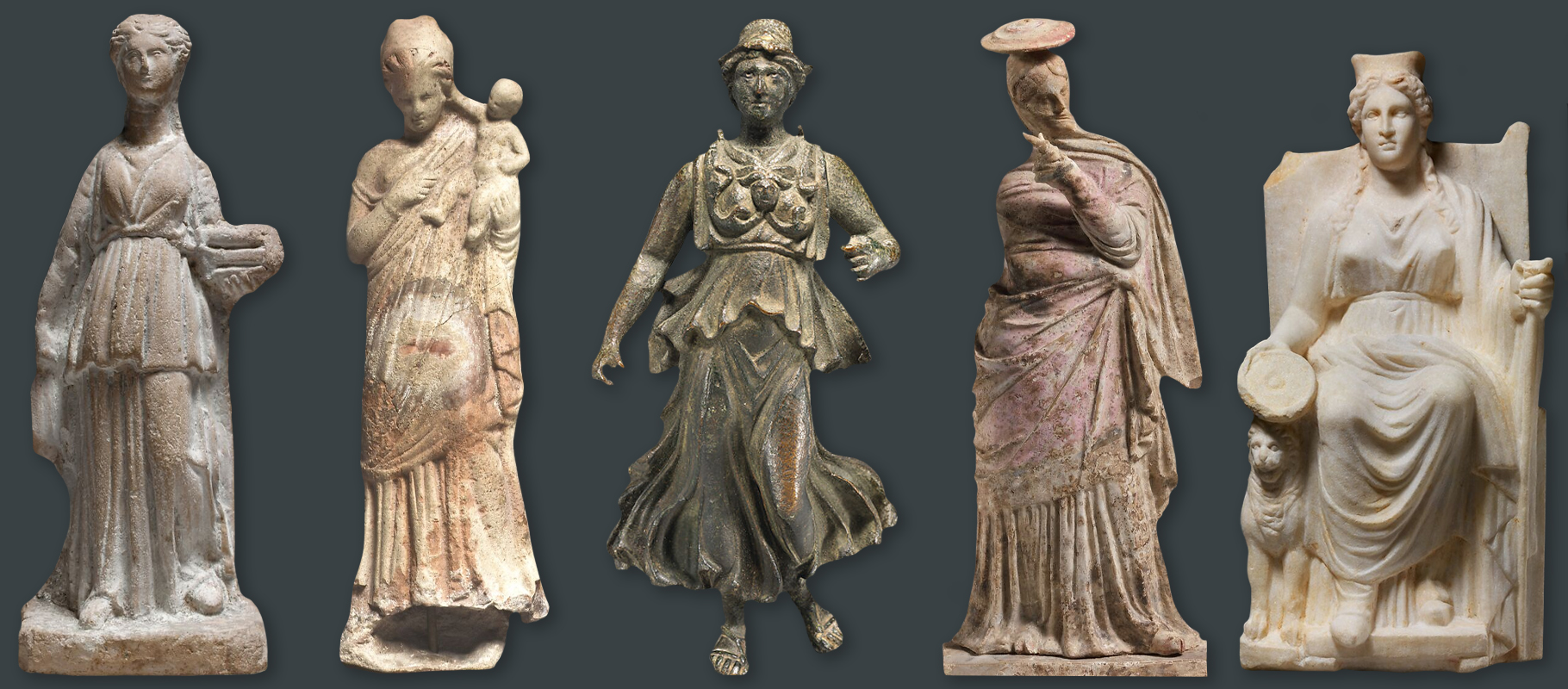 Above: a selection of ancient figurines from Greece and Rome
Above: a selection of ancient figurines from Greece and Rome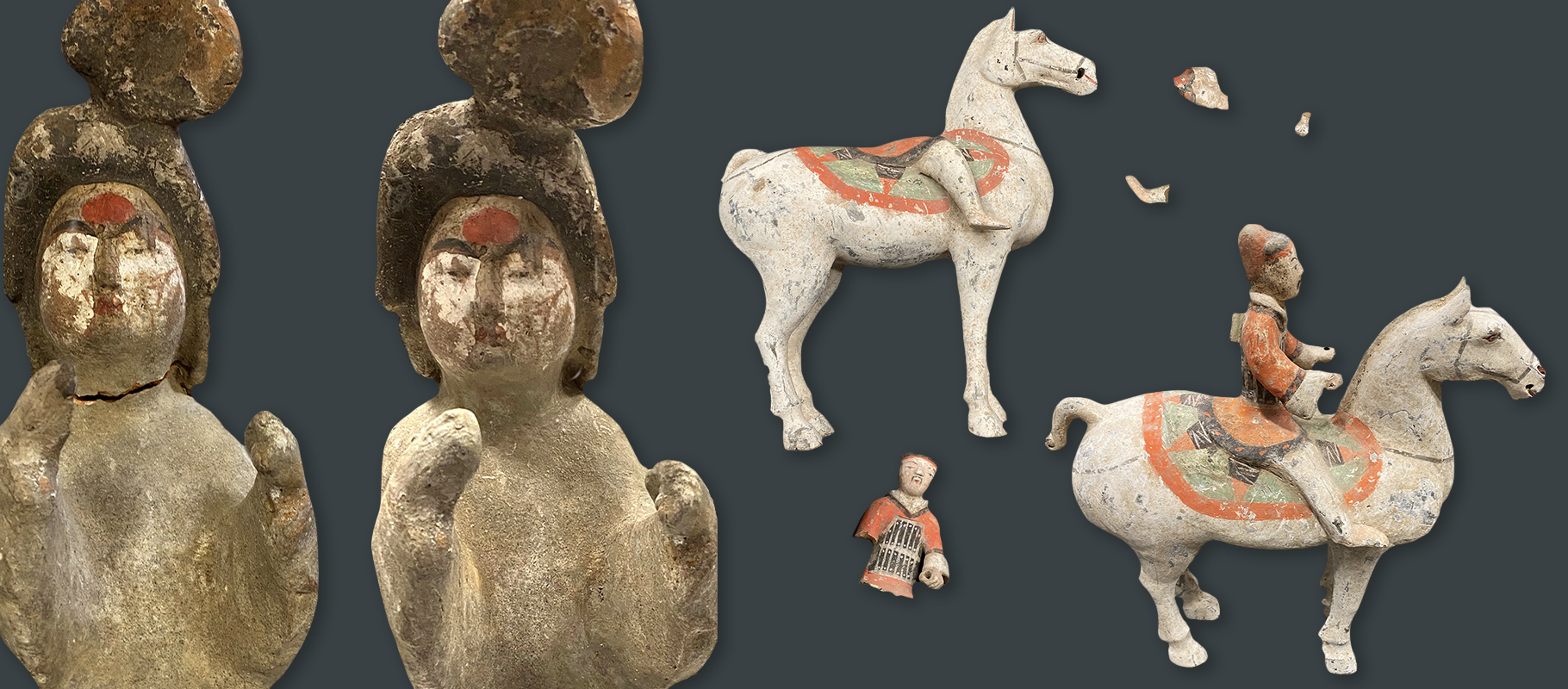 Above: two Tang dynasty figurines, before and after restoration by our conservator
Above: two Tang dynasty figurines, before and after restoration by our conservator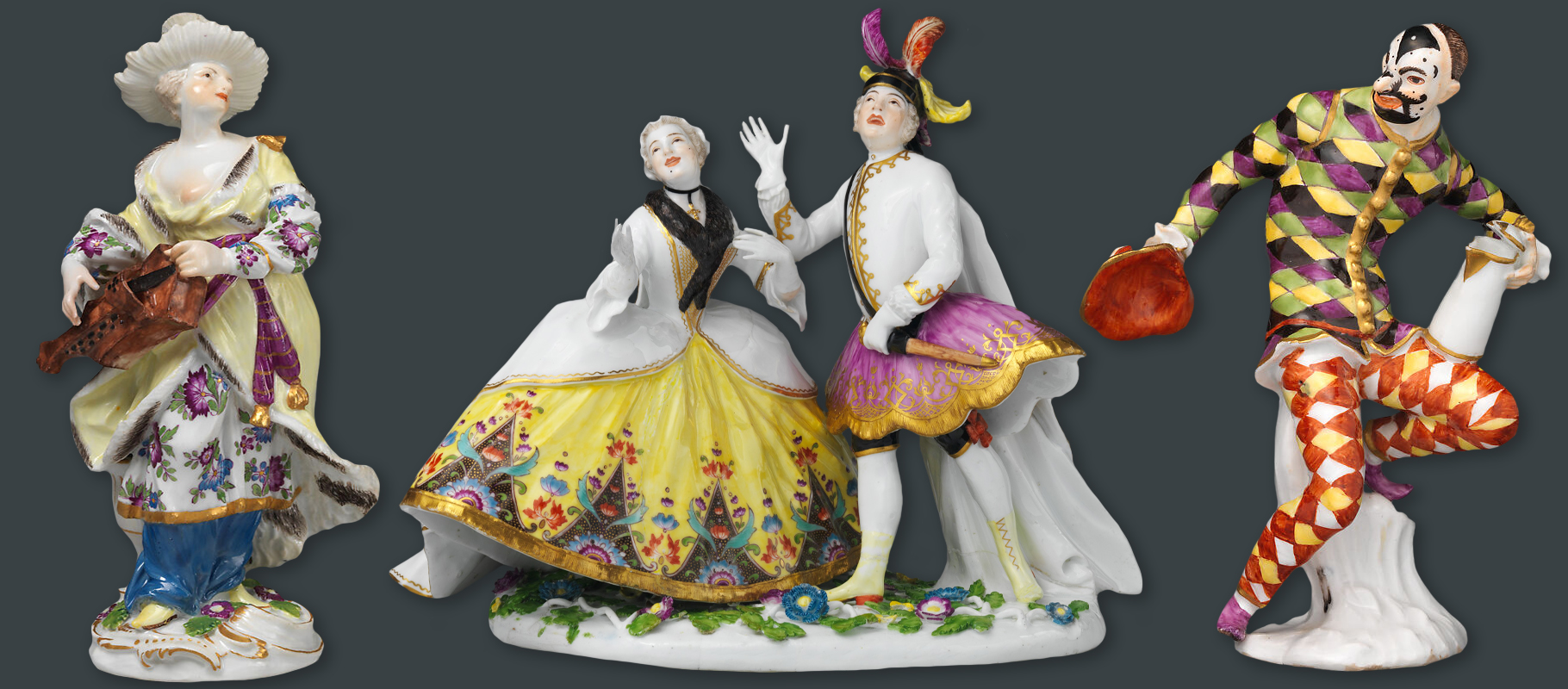 Above: a selection of Meissen figurines from the mid 18th century
Above: a selection of Meissen figurines from the mid 18th century Above: a group of Meissen card players, before and after restoration by our conservator
Above: a group of Meissen card players, before and after restoration by our conservator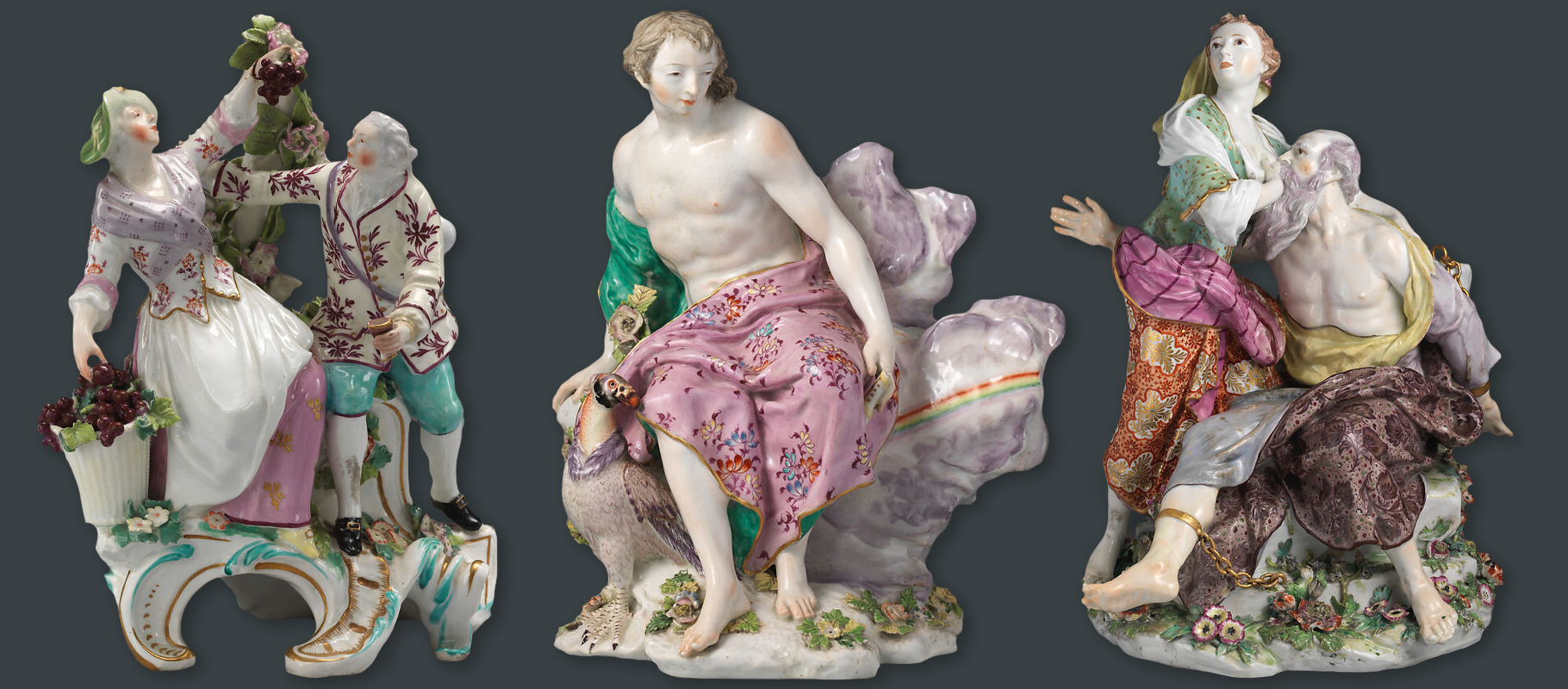 Above: three figurine examples from the Chelsea porcelain factory, all 18th century
Above: three figurine examples from the Chelsea porcelain factory, all 18th century Above: a selection of 19th century figurines
Above: a selection of 19th century figurines Above: an art deco figurine, before and after restoration by our conservator
Above: an art deco figurine, before and after restoration by our conservator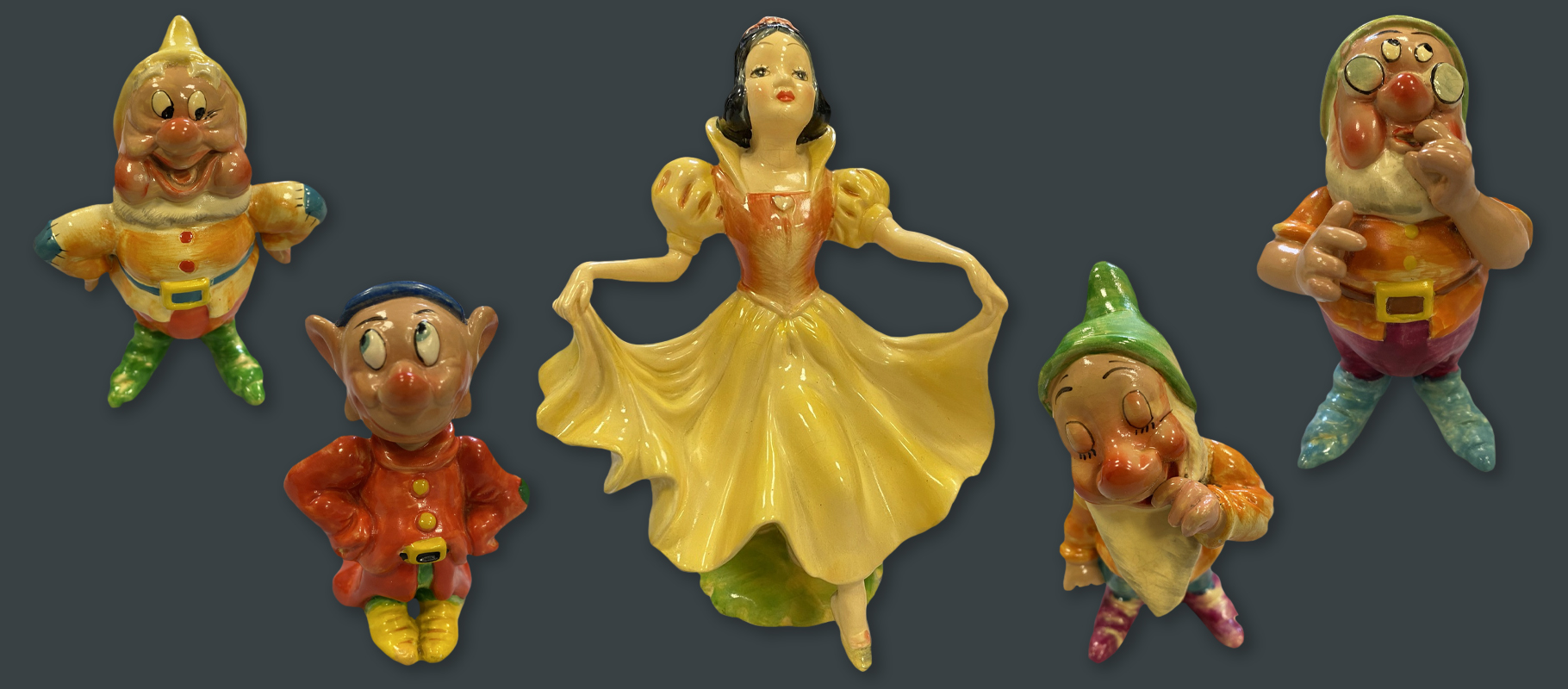 Above: a selection of Snow White figurines produced in 1930 by Wade, following restoration by our team
Above: a selection of Snow White figurines produced in 1930 by Wade, following restoration by our team Above: a Lladro figurine, before and after restoration by our conservator
Above: a Lladro figurine, before and after restoration by our conservator Above: a conservator assessing a figurine in our studio
Above: a conservator assessing a figurine in our studio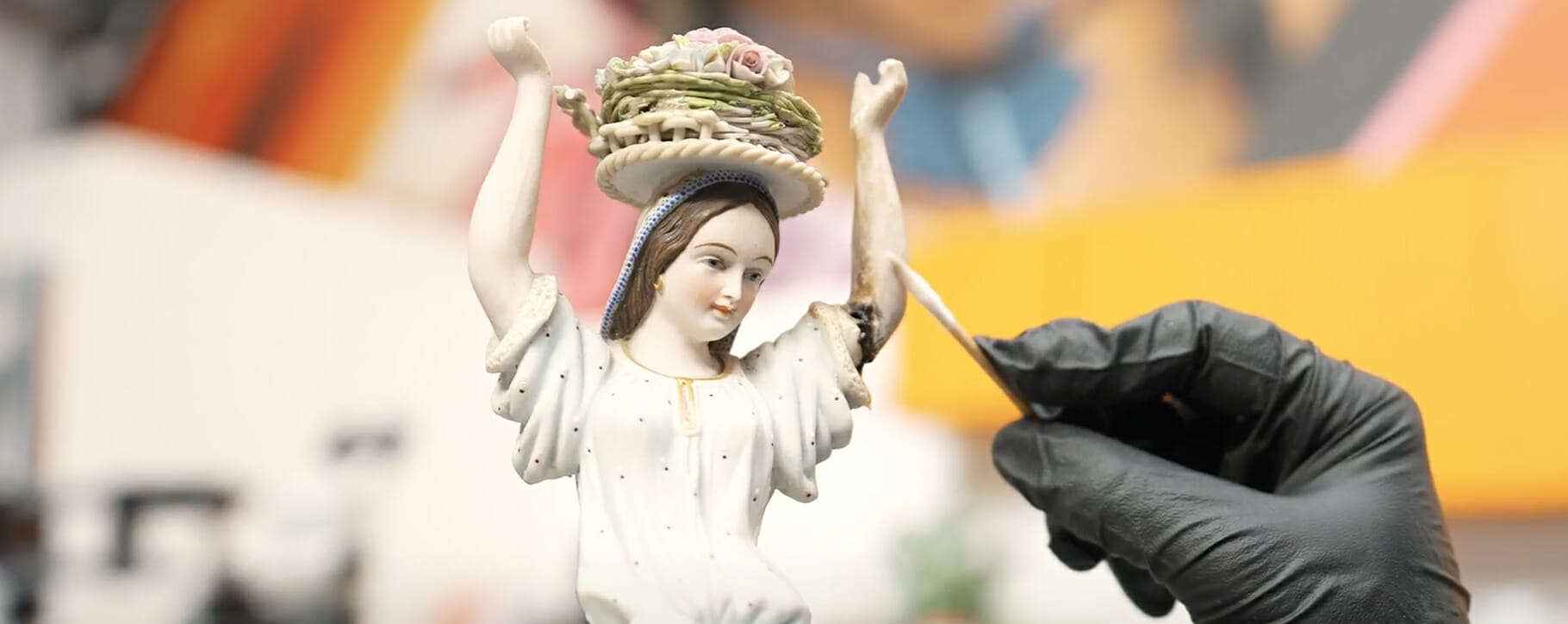 Above: a figurine undergoing the sensitive removal of old glue
Above: a figurine undergoing the sensitive removal of old glue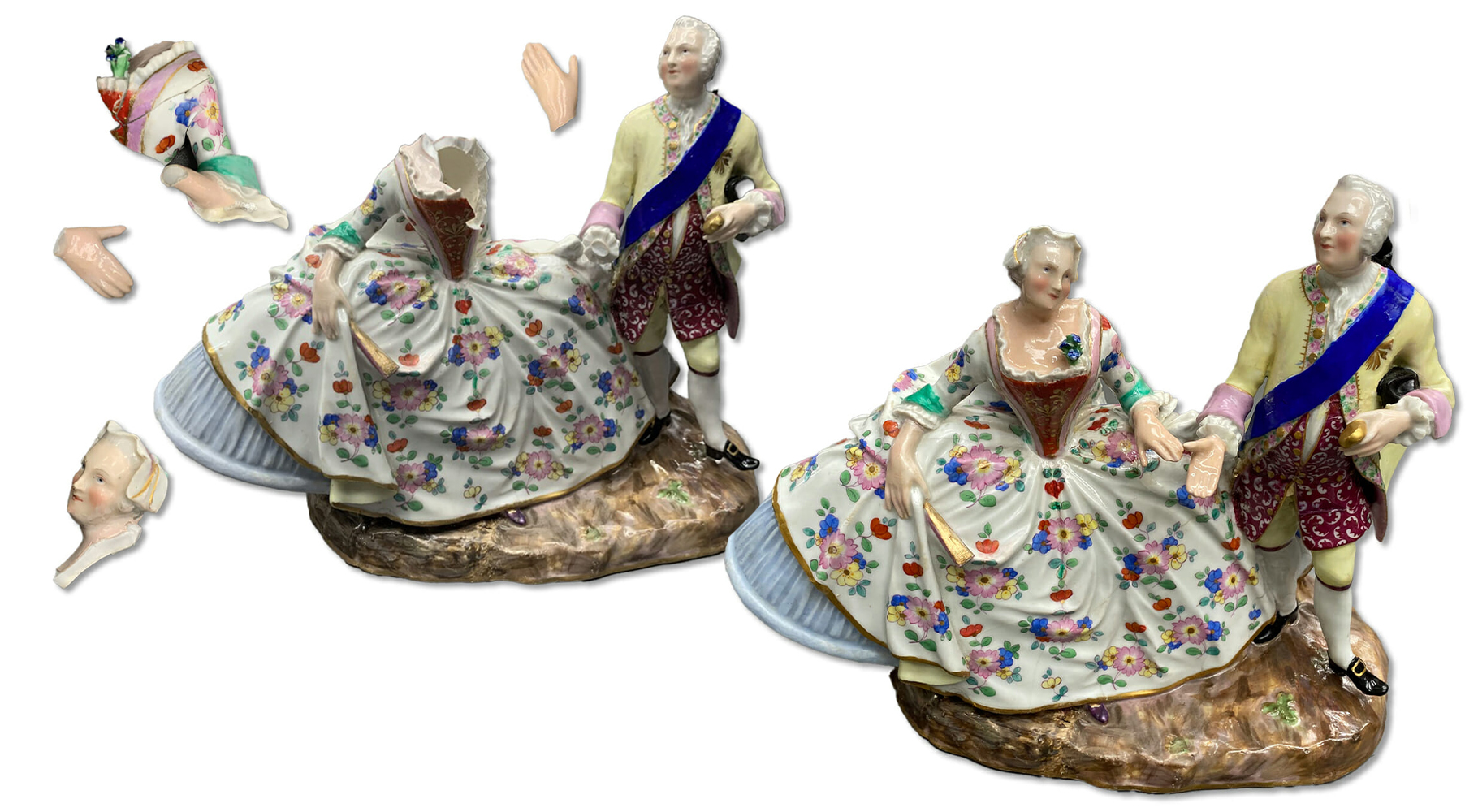
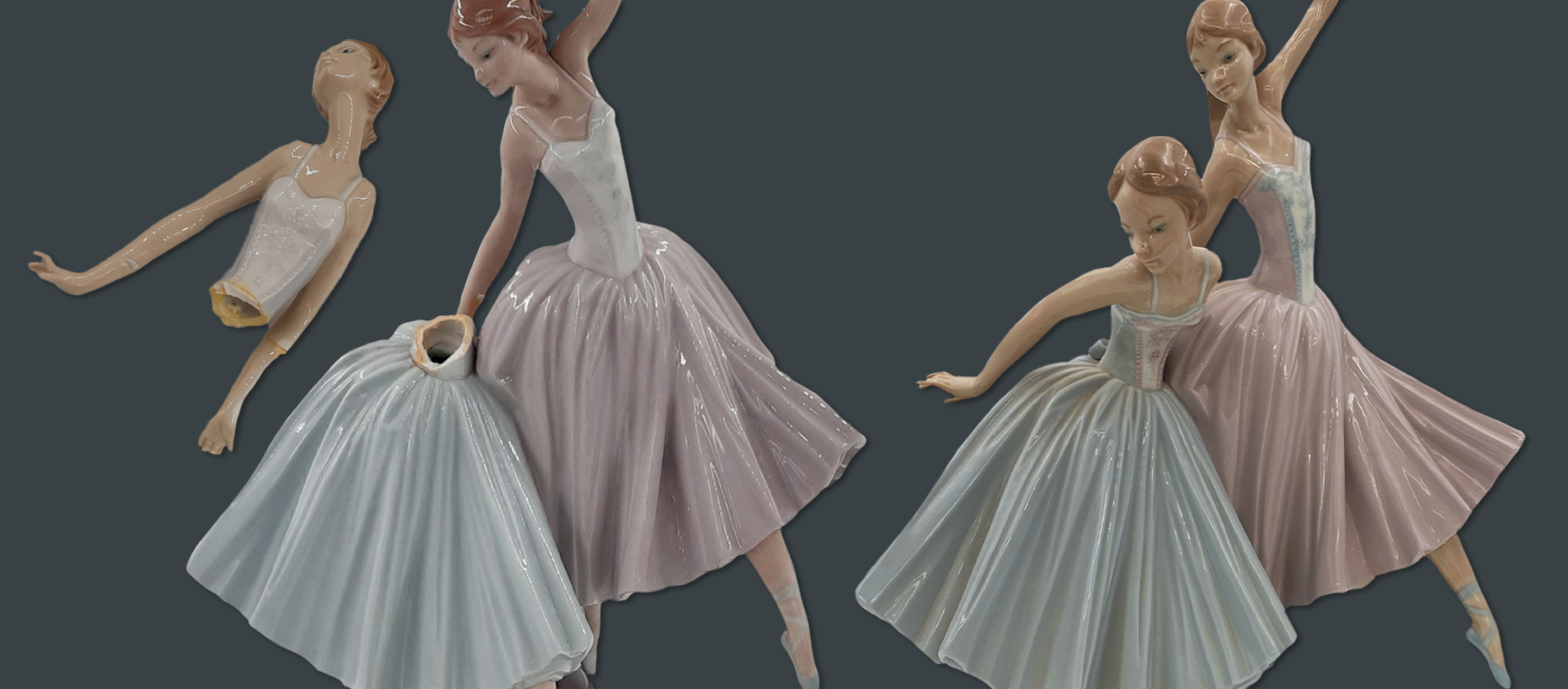 Above: ballet dancers by Lladro, before and after restoration by our conservator
Above: ballet dancers by Lladro, before and after restoration by our conservator